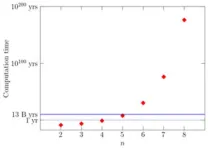(Press-News.org) INDIANAPOLIS -- Neighborhoods of high need are where investment in social care offers the best opportunities to improve health. Screening for social determinants of health is comparatively easy, but building the infrastructure to meet needs occurring outside the formal healthcare system is quite difficult. Few health systems have achieved more than even partial integration of social care into routine patient care.
In a case study of pioneering social care provided by Eskenazi Health, a safety net health system located in Indianapolis, researchers from Eskenazi Health, Regenstrief Institute and Indiana University School of Medicine highlight the human capital, operational redesign and financial investment needed by a safety net healthcare system to implement the National Academies of Science, Engineering and Medicine’s’ recommendations on integrating social care into medical care.
This insight is relevant to safety net health systems across the U.S. contemplating a greater role in social care for individuals living with high need as well as for their families and neighbors, current and potential employers, insurance companies, voters whose local, state and federal taxes help support safety net hospitals and policymakers who can decide to fund community improvements such as toxic cleanups, school renovations, public health initiatives or other ameliorations.
Individuals with high social need may be the people living next door, around the corner or across town. They may be a high achieving student at a poorly resourced school, a family living in a homeless shelter, a pregnant teen estranged from family or an older adult with dementia and a spouse caregiver who has provided care for years, but can no longer afford food due to medical debt and related expenses.
Food, housing, employment and transportation insecurity, air, water and land pollution, low economic opportunity, as well as neighborhood drug and gun violence are all health related social disparities lying outside the aegis of traditional healthcare. Eskenazi Health relies on "community weavers” to help primary care patients navigate the ecosystem of community-based services. These community weavers are employees, typically residing in one of the neighborhoods in which they work, who identify resources in the neighborhoods surrounding a clinical site, develop relationships with community organizations and help patients navigate access.
“We need to redesign the way we think about healthcare itself. An individual can receive excellent medical care but go home to a neighborhood where there's low educational attainment, racism, violence, pollution. And that may have a far more negative effect on health than the positive impact from several hours of interaction with the medical care system,” said lead author Christopher Callahan, M.D., Eskenazi Health chief research and development officer and a Regenstrief Institute research scientist. For more than two decades Dr. Callahan has developed, tested and implemented coordinated care models. Dr. Callahan is the founding director of the IU Center for Aging Research at Regenstrief Institute.
“As outlined in the case study we, with philanthropic support, are providing social care to improve health – contributing to the body of evidence that we hope will help payers like Medicaid and Medicare as well as private insurers to say and show with their actions, this is worth our investment,” he added.
Although the cost of a social care infrastructure will vary across different communities, the case study authors indicate that they anticipate that most health systems would need to invest at least $1 million to $3 million per year to build and maintain infrastructure for 5 to 10 years. Additionally, millions of dollars in financial support for day-to-day operations of social services potentially would be required.
“The upfront cost of building an infrastructure to address these social disparities will be high. Failing to address them, however, would ultimately be far costlier,” said case study senior author Lisa Harris, M.D., chief executive officer of Eskenazi Health and a Regenstrief Institute affiliate scientist. “We know that 80 percent of chronic disease can be prevented, better managed and, in some cases, even reversed by lifestyle changes and that low-income populations are most burdened by chronic disease precisely because of inequities in the opportunity of a healthy lifestyle.”
Eskenazi Health, the public hospital division of the Health & Hospital Corporation of Marion County, Indiana, is a safety net health system that includes a federally qualified health centers with multiple primary care locations in neighborhoods of high need.
“Building the Infrastructure to Integrate Social Care in a Safety Net Health System” is published in American Journal of Public Health.
Authors and affiliations
Christopher M. Callahan1, Amy Carter1, Hannah S. Carty1, Daniel O. Clark1, Tedd Grain1, Seth L. Grant1, Kimberly McElroy-Jones1, Deanna Reinoso1, Lisa E Harris1.
1Christopher M. Callahan, Amy Carter, Hannah S. Carty, Tedd Grain, Seth L. Grant, Kimberly McElroy-Jones, Deanna Reinoso, and Lisa E. Harris are with Eskenazi Health, Indianapolis, IN. Daniel O. Clark is with the Department of Medicine, Indiana University School of Medicine, Indianapolis. Drs. Callahan and Clark are Regenstrief Institute research scientists.
Christopher M. Callahan, M.D.
In addition to his role as a research scientist and the founding director of the Indiana University Center for Aging Research at Regenstrief Institute, Christopher M. Callahan, M.D., is chief research and development officer at Eskenazi Health and a professor of medicine at Indiana University School of Medicine – Indianapolis.
END
Redesigning healthcare: Integrating social care into a safety net health system
Building and maintaining infrastructure will require long-term investment by insurers and other payers
2024-05-09
ELSE PRESS RELEASES FROM THIS DATE:
Discovery made into which children will outgrow their peanut allergy
2024-05-09
Australian researchers have discovered how changes in antibody levels over time can predict which children are likely to outgrow their peanut allergy.
The research, led by Murdoch Children’s Research Institute (MCRI) in Melbourne and published in Allergy, found two thirds of children with a peanut allergy remain allergic by the age of 10. But for those who did naturally outgrow their allergy, the majority achieved this by six years old.
The study was the first to use antibodies as biomarkers to identify persistent or a resolved ...
Princeton physicists reveal the microscopic basis of a new form of quantum magnetism
2024-05-09
By Tom Garlinghouse for the Princeton University Department of Physics
Not all magnets are the same. When we think of magnetism, we often think of magnets that stick to a refrigerator’s door. For these types of magnets, the electronic interactions that give rise to magnetism have been understood for around a century, since the early days of quantum mechanics. But there are many different forms of magnetism in nature, and scientists are still discovering the mechanisms that drive them.
Now, physicists ...
Oikopleura who? Species identity crisis in the genome community
2024-05-09
When two animals look the same, eat the same, behave the same way, and live in similar environments, one might expect that they belong to the same species.
However, a tiny zooplankton skimming the ocean surfaces of microscopic food particles challenges this assumption. Researchers from Osaka University, University of Barcelona and the Okinawa Institute of Science and Technology (OIST) have analyzed the genome of Oikopleura dioica from the Seto Inland Sea, the Mediterranean, and the Pacific Ocean around the Okinawa Islands, and in doing so, they have raised numerous questions about speciation and the role of gene location in ...
Developed compiler acceleration technology for quantum computers
2024-05-09
[Highlights]
- Developed a new compilation method to generate optimal sequences to be executed on quantum computers
- The new method is based on a probabilistic approach and reduces the time to search for the optimal sequence by several orders of magnitude.
- Expected to contribute to quantum information processing at quantum nodes that support the quantum internet
[Abstract]
The National Institute of Information and Communications Technology (NICT, President: TOKUDA Hideyuki, Ph.D.), RIKEN (President: GONOKAMI Makoto, Ph.D.), Tokyo University of Science (President: Dr. ISHIKAWA Masatoshi), and the University of Tokyo (President: FUJII Teruo, Ph.D.) succeeded ...
Report: Governments falling short on promises of effective biodiversity protection
2024-05-09
WASHINGTON— A new analysis of the world’s largest 100 marine protected areas (MPAs) published today in Conservation Letters suggests that governments are falling short on delivering the promise of effective biodiversity protection due to slow implementation of management strategies and failure to restrict the most impactful activities.
The assessment, titled “Ocean protection quality is lagging behind quantity: Applying a scientific framework to assess real marine protected area progress ...
Study shows how night shift work can raise risk of diabetes, obesity
2024-05-09
Just a few days on a night shift schedule throws off protein rhythms related to blood glucose regulation, energy metabolism and inflammation, processes that can influence the development of chronic metabolic conditions.
The finding, from a study led by scientists at Washington State University and the Pacific Northwest National Laboratory, provides new clues as to why night shift workers are more prone to diabetes, obesity and other metabolic disorders.
“There are processes tied to the master biological clock in our brain that are saying that day ...
Eleventh Nano Research Award goes to Louis E. Brus and Moungi Bawendi
2024-05-09
Recently, Nano Research announced awardees of the 11th Nano Research Award. Two outstanding scientists, Professor Louis E. Brus of Columbia University and Professor Moungi Bawendi of Massachusetts Institute of Technology, have been awarded this honor.
The Nano Research Award, established by the journal Nano Research together with Tsinghua University Press (TUP) and Springer Nature in 2013, aims to recognize outstanding contributions to nano research by an individual scientist. The winner is selected by the Award Committee ...
Traffic injuries to low-income NYC residents fell 30% in first five years of ‘vision zero’ road safety program, NYU study finds
2024-05-09
Among New Yorkers with low incomes, the “Vision Zero” initiative to stem roadway crashes resulted in a marked, 30% reduction in traffic injuries of varying severity from early 2014 – when the city government launched the program – until 2019, according to a new study conducted at New York University.
The study, scheduled for publication May 8 at 4:00 p.m. (ET) in the American Journal of Public Health, revealed this trend of improved safety by comparing Medicaid-covered injury ...
AI tool instantly assesses self-harm risk
2024-05-09
Suicidality hit new record high in U.S. in 2022
New tool was 92% effective at predicting four variables related to self-harm
AI uses a small set of judgment and contextual variables as opposed to big data, and strongly supports the hypothesis of a standard model of mind
EVANSTON, Ill. --- A new assessment tool that leverages powerful artificial intelligence was able to predict whether participants exhibited suicidal thoughts and behaviors using a quick and simple combination of variables.
Developed by researchers at Northwestern University, the University of Cincinnati (UC), Aristotle ...
An epigenome editing toolkit to dissect the mechanisms of gene regulation
2024-05-09
Understanding how genes are regulated at the molecular level is a central challenge in modern biology. This complex mechanism is mainly driven by the interaction between proteins called transcription factors, DNA regulatory regions, and epigenetic modifications – chemical alterations that change chromatin structure. The set of epigenetic modifications of a cell’s genome is referred to as the epigenome.
In a study just published in Nature Genetics, scientists from the Hackett Group at EMBL Rome have developed a modular epigenome editing platform – a system to program epigenetic modifications at any location in the genome. The system allows scientists to study the impact ...
LAST 30 PRESS RELEASES:
Can community awareness campaigns in low-resource areas improve early diagnosis of colorectal cancer?
Stardust study resets how life’s atoms spread through space
Practical education: Clinical scenario-based program development
The impact of family dynamics on eating behaviour – how going home for Christmas can change how you eat
Tracing the quick synthesis of an industrially important catalyst
New software sheds light on cancer’s hidden genetic networks
UT Health San Antonio awarded $3 million in CPRIT grants to bolster cancer research and prevention efforts in South Texas
Third symposium spotlights global challenge of new contaminants in China’s fight against pollution
From straw to soil harmony: International team reveals how biochar supercharges carbon-smart farming
Myeloma: How AI is redrawing the map of cancer care
Manhattan E. Charurat, Ph.D., MHS invested as the Homer and Martha Gudelsky Distinguished Professor in Medicine at the University of Maryland School of Medicine
Insilico Medicine’s Pharma.AI Q4 Winter Launch Recap: Revolutionizing drug discovery with cutting-edge AI innovations, accelerating the path to pharmaceutical superintelligence
Nanoplastics have diet-dependent impacts on digestive system health
Brain neuron death occurs throughout life and increases with age, a natural human protein drug may halt neuron death in Alzheimer’s disease
SPIE and CLP announce the recipients of the 2025 Advanced Photonics Young Innovator Award
Lessons from the Caldor Fire’s Christmas Valley ‘Miracle’
Ant societies rose by trading individual protection for collective power
Research reveals how ancient viral DNA shapes early embryonic development
A molecular gatekeeper that controls protein synthesis
New ‘cloaking device’ concept to shield sensitive tech from magnetic fields
Researchers show impact of mountain building and climate change on alpine biodiversity
Study models the transition from Neanderthals to modern humans in Europe
University of Phoenix College of Doctoral Studies releases white paper on AI-driven skilling to reduce burnout and restore worker autonomy
AIs fail at the game of visual “telephone”
The levers for a sustainable food system
Potential changes in US homelessness by ending federal support for housing first programs
Vulnerability of large language models to prompt injection when providing medical advice
Researchers develop new system for high-energy-density, long-life, multi-electron transfer bromine-based flow batteries
Ending federal support for housing first programs could increase U.S. homelessness by 5% in one year, new JAMA study finds
New research uncovers molecular ‘safety switch’ shielding cancers from immune attack
[Press-News.org] Redesigning healthcare: Integrating social care into a safety net health systemBuilding and maintaining infrastructure will require long-term investment by insurers and other payers



